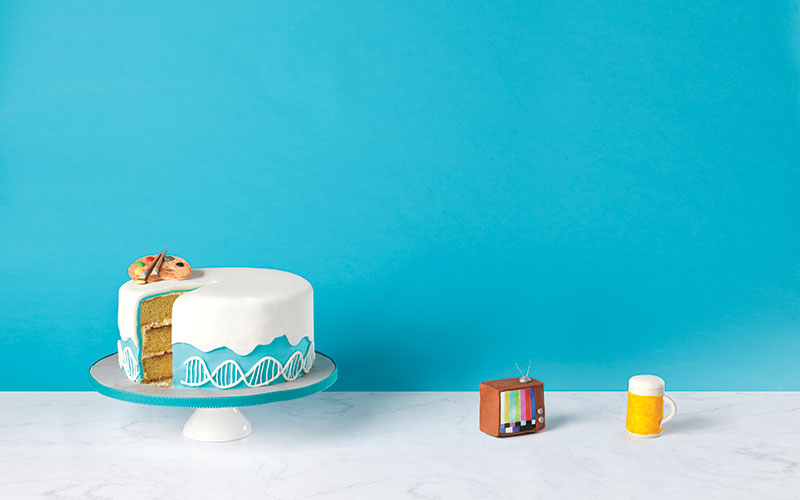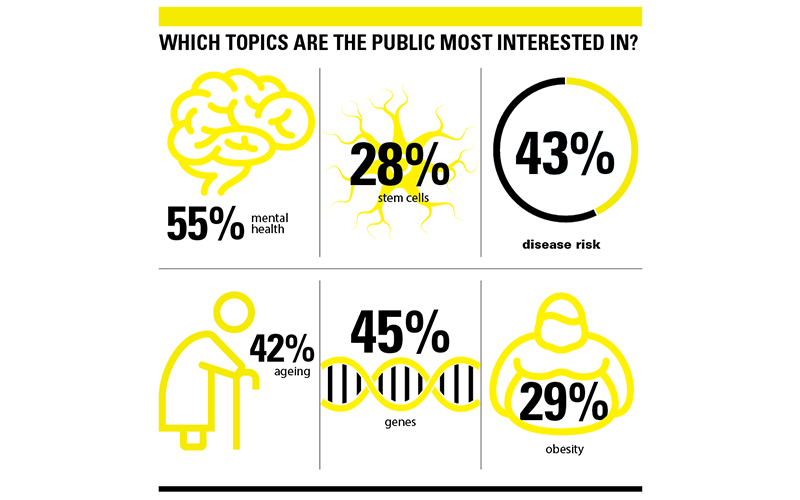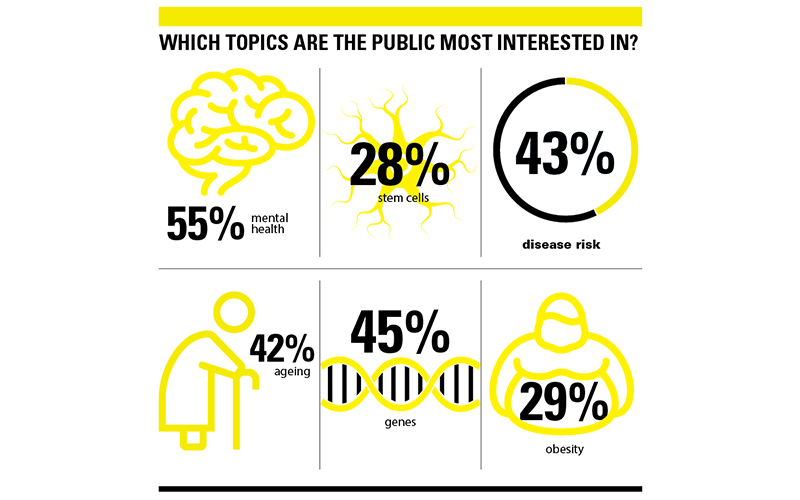Can baking, art, pubs and television alter views of science? We look at the innovative ways in which the sector’s profile is being raised.

There are three types of people who recognise me: those who side-glance and pretend they don’t see me, those who watch me and think I don’t realise, and those who come up to me and say ‘hello’.” The man Yan Tsou has just spoken to in the Francis Crick Institute reception falls into the latter category. He approached, stared and asked: “Where do I know you from?”
Yan is meeting The Biomedical Scientist days after the final episode of the Great British Bake Off was beamed into 7.7m UK homes. Despite being knocked out with three weeks remaining, Yan, who describes herself as “friendly but shy”, is probably the best-known biomedical scientist in the country right now.
“Most people are very British and don’t bother me. Luckily, the people who come up to me want to talk about science. That’s great, because I’m not good at talking with strangers, but I can engage when it comes to science.”
The scientist who bakes
Yan’s biomedical background is something she proudly promoted on the show, from her opening week creating “mango salmon roe” made with liquefied agar – a substance she was using in the lab just days before filming – through to her scientific equation for the perfect pastry-to-pie-filling ratio – it didn’t work perfectly, as it was originally designed for a mince pie, she says.
“When you’ve got this scientific knowledge at your finger tips, why not use it?” she asks. “Science is ingrained in me – it’s all about science. I’m used to training others at work, so on the Bake Off I explained what I was doing as if I was training someone in the lab.”
Yan is insistent that she is “not the baking scientist, but the scientist who bakes” and says the most important thing is to use her newly-found platform to raise science’s profile. “Raising awareness can only be a good thing – the public just see frontline staff, they don’t realise that there are biomedical scientists in the background, working through the night and on holidays, to keep the NHS going.”
She continues: “There’s a lot of pressure to give up your current life and become a baking celebrity, but I haven’t done all my training just to give it up. I’m excited to explain to people what science is and I feel that there is a lot of good that I can do.”
Engaging and inspiring
Working as a Laboratory Research Scientist at the Crick, a £700m biomedical research centre in London, Yan is in the ideal environment to spread the word about biomedical science. The institute has an extensive public outreach programme, in which more than 30,000 people have been involved in its launch 15 months ago (see box, overleaf).
“Engaging and inspiring the public is one of our top priorities – in fact, we believe it’s critical to our success as an institute,” says Katie Matthews, Director of Public Engagement at the Crick. “It is really important for biomedical science, which offers profound opportunities to society, but also raises important questions that the public need to be involved in discussing. Some of the research that the Crick is doing, such as stem cell research, regenerative medicine and the biology of ageing, has fundamental implications for our society and its future direction.”
She continues: “Public interest in science and research has definitely increased. This has been helped hugely by great science communicators like David Attenborough, Alice Roberts and Brian Cox, as well as by the excellent public engagement being done by institutions throughout the country.
“There’s also increased skepticism and challenge from the public and a lack of trust in experts; the media is often accused of sensationalising; and there’s misunderstanding and confusion about some areas of research. But this offers great opportunities for engagement and the chance to help develop a more scientifically literate society.”
Public attitudes
The most recent government Public Attitudes to Science Survey (2014), shows that 68% of the public surveyed say they know what scientists do. However, when it comes to research, 35% think scientists adjust their findings to get the answers they want, while 29% think scientific research is never, or only occasionally, checked by other scientists.
While 55% of people say they do not feel informed about science, 84% agree that science is such a big part of our lives that we should all take an interest, and 72% agree that it is important to know about it in their daily lives.
However, good intentions don’t always result in actions. Last year the Wellcome Trust, an independent global charitable foundation dedicated to improving health, published figures showing that 20% of people surveyed said they would be interested in listening to a lecture, but only 7% actually did so. In 2013, the trust surveyed the public specifically about biomedical science and found three-quarters of adults and more than half of young people were a least “fairly interested”. The areas they wanted to know the most about were the development of drugs, vaccines and treatments and how the body and brain work (see box for more).
There are numerous ways in which scientists are trying to take advantage of this willingness to learn, including a range of innovative boundary-challenging approaches to spreading the word.
Art and science
“Young people aren’t going to engage with evening debates about science,” says Dr Daniel Glaser.
“You need to create a more playful space that appeals to them on their own terms.” Dr Glaser is Director of the Science Gallery at King’s College London, which is due to open in Spring 2018.
The venue, nestled at the foot of the Shard in London, is billed as a space “where art and science collide”. In advance of its launch, the gallery ran a pop-up show in Peckham, South-East London. BLOOD: Life Uncut was an exhibition in which scientists were paired with artists to collaborate on new works. These covered menstruation, Ebola, sickle cell anaemia, blood donation, forensics and blood typing.
“You can’t understand blood solely in an artistic or a scientific context. You can explain everything about blood to someone, but this still wouldn’t allow them to understand why some people faint at the sight of blood,” says Dr Glaser. “But for the ‘selfie generation’, the idea of science and art together is very natural, they don’t see these things as separate.”
Mike Shattock, Professor of Cellular Cardiology at King’s College, is one of the clinicians who has worked on The Body is a Big Place – a Science Gallery project that has included keeping a pigs heart beating outside the body.
“It stopped beating after two hours, and I was disappointed because I knew we could do four to six hours,” he explains.
“It is unnatural for me – I have not got an artistic bone in my body, but it all comes back to increasing discourse around science and the general public. Anything that can act as a conduit to increase our ability to talk about and understand science has got to be good.”

Science fiction?
Pint of Science is an annual festival that brings researchers to local pubs to showcase the latest work and developments in science. This year, it held nearly 450 events across 26 cities in the UK, involving over 1,000 scientists. Throughout the year, it also runs monthly events in pubs around the country.
Praveen Paul is Pint of Science’s Director and Co-Founder and decided to set up the initiative after “a lot of time looking down microscopes researching neurodegeneration” as a post-doctoral researcher. “We thought that it was a bit strange that we never really met people or families affected by the very conditions that we studied,” she says. “When we told our non-scientist friends we were growing cells in a dish, they thought it was the stuff of science fiction.”
The aim is to give scientists a platform to share their discoveries, journeys and challenges; giving the public the chance to “question the scientists directly, rather than hearing or reading information from a third source”. To Praveen, the pub seemed the obvious location for this: “Holding talks and hands-on events in a relaxed atmosphere encourages discussion and breaks down barriers; there is no ‘us’ and ‘them’ – we’re all in the same boat learning as we go along.”
Breaking barriers
Explaining the benefits of public engagement, she says: “The public effectively funds scientific research, yet, in many cases solid scientific work is mistrusted due to misconception and lack of personal connection.
“Once people can interact with scientists they start to relate to them; not as people who work with a specific agenda, but as people who have a deep interest and passion for some of the most challenging problems we face. It also inspires people to get involved and shows that anyone can be a scientist if they dedicate the time to it – it’s not an exclusive club.”
Professor Shattock agrees. “If you can explain science in a pub, then that’s a really great thing – the more you can get people talking and thinking about science, the better. There are some great scientists on TV at the moment, like Brian Cox and Tim Peake and if people start talking about science because of the Great British Bake Off, that’s brilliant.” He concludes: “We need to break down barriers so that the general public understand diseases and conditions better and anything that can increase awareness is good.”
Scientists are reaching out beyond the confines of their labs in new ways. Who knows – the public may find scientific truth in an art installation, a TV screen, at the bottom of a pint glass, or even in the soggy bottom of a Victoria sponge.

